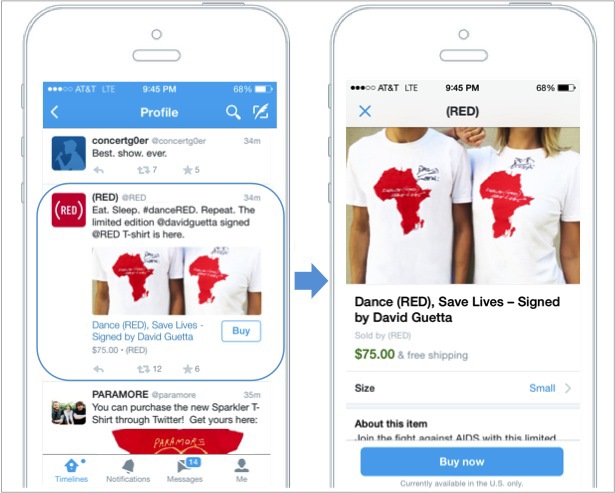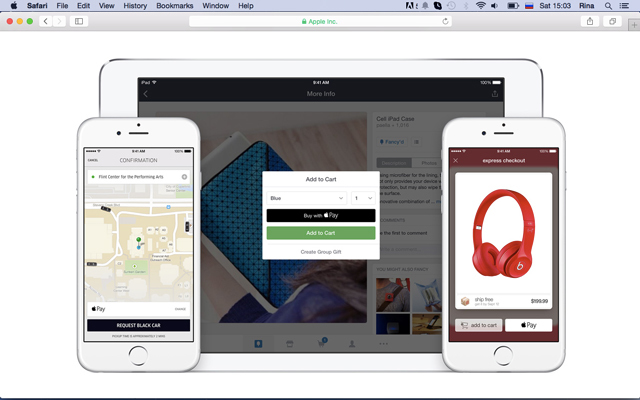Innovations in ecommerce that can change the usual online shopping
Some new products take their place in our lives unnoticed. But when the business of life is somehow connected with IT, it is important to see trends in time and take advantage of them.
Today we will discuss innovations in the field of ecommerce, which, perhaps, in a couple of years will change our idea of online shopping, and some of them you can try in your business today.
Shopping through social media
Amazon, one of the world leaders in e-commerce, has been gathering crowds of loyal and paying customers for years. In early May 2014, the company introduced AmazonCartthe ability for customers to add products to their cart directly from Twitter. To make it work, you need to connect your Amazon and Twitter accounts. After that, you can add your favorite product from Amazon tweets to the basket or wishlist by simply responding to the message with the hashtag #AmazonCart or #AmazonWishList. The next time you visit the site, the product will already be in the basket (wishlist) and the user no longer needs to wander around the site for hours in search of what once caught my eye on Twitter.
It turned out to be so convenient that in the first two weeks of the service, it was used 157,000 times.
Vogue, the most famous fashion magazine, uses interagrams to help readers find where to buy their favorite item (there are tags for a designer or store near things).

Many, even small online stores for smm sales use the special Soldsie service , which allows you to send an invoice to the buyer after he wrote a “sold“ comment under the desired product. The letter contains the details of the order and details for payment by card or via PayPal.

Selling jewelry via Prep Obsessed's facebook page
Meanwhile, Twitter announced on its blog that some American brands will be able to sell their products in the near future by embedding the “buy” button directly on tweet.

There's also announced an initial list of brand partners, including Burberry (@ burberry ), Eminem (@ eminem ), Panic! At The Disco (@ panicatthedisco ).
Electronic payment systems, wallets and virtual currency
Do not you think that entering every time you buy 16 digits from a card is a little tedious? Especially from the small screen of a smartphone. That is why, with the rise of mobile ecommerce, many mobile wallets and alternative payment methods appeared on the market and over time, they will only gain popularity, which is worth considering.

walletone is one of the many mobile wallets on the market
September 9, Apple introduced its payment service ApplePay. The user only needs to enter their card details once using the camera or manually, and you can make purchases simply by choosing ApplePay from the proposed payment methods (in addition to offline purchases using NFC). So far, this only works in iTunes for owners of six iPhones, but since the API is open to developers, the market expects a number of interesting innovations that will affect the market.
Already, ApplePay is compatible with readers Visa PayWave, MasterCard PayPass, American Express ExpressPay, and hundreds of banks and large retail chains have announced support for this system.

Using the same technology, GoogleWallet, released in 2011, is a payment system developed by Google and released for users of Android devices. In addition, it is possible to order a regular debit card and pay it in stores.

This is what the GoogleWallet Card looks like. Image taken from techcrunch.com
On the one hand, there are a lot of advantages in electronic wallets and payment systems. On the other hand, if the user is worried about security (and we all worry about the security of our credit cards), then a purchase using GoogleWallet may look like this: take out the phone, unlock the screen and enter the password (use a smartphone that contains personal information, access to mail , social networks and applications, without additional access restrictions - it is unreasonable, because we have password protected it in advance), click on the Wallet icon, which can also be password protected and for good reason (no one will be able to pay without your PIN code, but find out all the details whether your transaction is easy), enter the password, wait until it boots up, and finally enter the PIN code. At any moment of this process, well, we are realistic, an application can, for example, crash due to lack of RAM. Imagine the chagrin of a man who was just trying to buy a cup of coffee.
Meanwhile, bitcoins continue to gain popularity around the world, now they can be removed at special ATMs.

bitcoin-ATM card
Delivery to the store
Logistics costs are one of the most difficult things for owners of online stores. According to surveys, up to 82% of buyers will prefer a site with free delivery. And about 61% will choose to cancel the purchase if the delivery is paid.
A good alternative is to abolish delivery altogether. A person makes a purchase on the site, and picks it up at the nearest store, without waiting and queues. A convenient option for developed retail chains like walmart.com and bestbuy.com, and for small stores. For example, stock clothing store Reduses such delivery for customers in Kiev. This is convenient for buying clothes that you can measure and replace right in the store if you don’t fit, while avoiding hours of combing all the shelves in search of specific things, all this work is done for the buyer by filters in the online store.

The first to invent and implement such a service in the Nordstrom store in 2008, whereby store sales grew by 8% and revenue by 42% over 4 years.
Content-oriented online stores.
Most sellers and store owners display their goods on the site in the same way as they would show them in an offline store. The trouble is that a user on the Internet behaves in a completely different way than when he comes to the store and looks at products on the shelves.
On the one hand, in an ordinary store, a person cannot watch a product overview or teleport from one point of sale to another to compare offers, switching between e-shop tabs is easy, simple and pleasant.
Some ecommerce sites have caught this difference, for example, the popular Net-a-porter and Joyus stores present their products more interactively, rather than just pouring tons of items, prices and specifications.

These stores took as their basis the original, magazine style of the demonstration, they offer a video on which you can see how the thing sits when moving, whether it stretches, what the fabric looks like under different lighting. In addition, there you can see the advice of stylists on accessories that are suitable for a thing and how you can wear it for different situations and occasions.

Such a presentation is more like getting to know a product than just a warehouse price list, as it was a few years ago. Of course, first of all, this approach is valuable for sellers of cosmetics, clothes, accessories and beautiful gizmos for the interior. But knowing how important it is for a person to “see” his purchase and its place in his life, sellers of absolutely any product can benefit.
Work with big data
At the moment, buyers and businesses generate a huge amount of data that companies are already trying to collect, organize and use. So far, not everyone succeeds, but having a wealth of data for analytics, in the coming years, companies will be able to focus on tasks and problems, which, in turn, will change the scale of decisions made in the process of work and customer service.
Instead of drawing up comprehensive instructions for creating an “ideal” result, there will be more opportunity for micro-solutions related to all aspects of the business. For example, “how to reduce delivery time to city N“, “how to return buyers of food for large dogs that have become inactive in recent months and why they have lost their loyalty.”
Companies will try to do not “cool for everyone,” but “cool for everyone.”

Amazon sends personalized emails with products similar to those that the recipient has already bought or added to the wish list. Also in such letters are accessories for already purchased goods. Image taken from conversionxl.com
E-commerce is fertile ground for experimentation and innovation. The flexibility of the sphere and the ability to quickly introduce any new product into the work allows you to test any ideas and strategies. If successful, the bonus will be a serious boost to business and new ways of generating income. Of course, failures are also possible, in order to survive them with minimal losses, it is worth approaching the experiments from the point of view of common sense and timely evaluating their results.
Today we will discuss innovations in the field of ecommerce, which, perhaps, in a couple of years will change our idea of online shopping, and some of them you can try in your business today.
Shopping through social media
Amazon, one of the world leaders in e-commerce, has been gathering crowds of loyal and paying customers for years. In early May 2014, the company introduced AmazonCartthe ability for customers to add products to their cart directly from Twitter. To make it work, you need to connect your Amazon and Twitter accounts. After that, you can add your favorite product from Amazon tweets to the basket or wishlist by simply responding to the message with the hashtag #AmazonCart or #AmazonWishList. The next time you visit the site, the product will already be in the basket (wishlist) and the user no longer needs to wander around the site for hours in search of what once caught my eye on Twitter.
It turned out to be so convenient that in the first two weeks of the service, it was used 157,000 times.
Vogue, the most famous fashion magazine, uses interagrams to help readers find where to buy their favorite item (there are tags for a designer or store near things).

Many, even small online stores for smm sales use the special Soldsie service , which allows you to send an invoice to the buyer after he wrote a “sold“ comment under the desired product. The letter contains the details of the order and details for payment by card or via PayPal.

Selling jewelry via Prep Obsessed's facebook page
Meanwhile, Twitter announced on its blog that some American brands will be able to sell their products in the near future by embedding the “buy” button directly on tweet.

There's also announced an initial list of brand partners, including Burberry (@ burberry ), Eminem (@ eminem ), Panic! At The Disco (@ panicatthedisco ).
Electronic payment systems, wallets and virtual currency
Do not you think that entering every time you buy 16 digits from a card is a little tedious? Especially from the small screen of a smartphone. That is why, with the rise of mobile ecommerce, many mobile wallets and alternative payment methods appeared on the market and over time, they will only gain popularity, which is worth considering.

walletone is one of the many mobile wallets on the market
September 9, Apple introduced its payment service ApplePay. The user only needs to enter their card details once using the camera or manually, and you can make purchases simply by choosing ApplePay from the proposed payment methods (in addition to offline purchases using NFC). So far, this only works in iTunes for owners of six iPhones, but since the API is open to developers, the market expects a number of interesting innovations that will affect the market.
Already, ApplePay is compatible with readers Visa PayWave, MasterCard PayPass, American Express ExpressPay, and hundreds of banks and large retail chains have announced support for this system.

Using the same technology, GoogleWallet, released in 2011, is a payment system developed by Google and released for users of Android devices. In addition, it is possible to order a regular debit card and pay it in stores.

This is what the GoogleWallet Card looks like. Image taken from techcrunch.com
On the one hand, there are a lot of advantages in electronic wallets and payment systems. On the other hand, if the user is worried about security (and we all worry about the security of our credit cards), then a purchase using GoogleWallet may look like this: take out the phone, unlock the screen and enter the password (use a smartphone that contains personal information, access to mail , social networks and applications, without additional access restrictions - it is unreasonable, because we have password protected it in advance), click on the Wallet icon, which can also be password protected and for good reason (no one will be able to pay without your PIN code, but find out all the details whether your transaction is easy), enter the password, wait until it boots up, and finally enter the PIN code. At any moment of this process, well, we are realistic, an application can, for example, crash due to lack of RAM. Imagine the chagrin of a man who was just trying to buy a cup of coffee.
Meanwhile, bitcoins continue to gain popularity around the world, now they can be removed at special ATMs.

bitcoin-ATM card
Delivery to the store
Logistics costs are one of the most difficult things for owners of online stores. According to surveys, up to 82% of buyers will prefer a site with free delivery. And about 61% will choose to cancel the purchase if the delivery is paid.
A good alternative is to abolish delivery altogether. A person makes a purchase on the site, and picks it up at the nearest store, without waiting and queues. A convenient option for developed retail chains like walmart.com and bestbuy.com, and for small stores. For example, stock clothing store Reduses such delivery for customers in Kiev. This is convenient for buying clothes that you can measure and replace right in the store if you don’t fit, while avoiding hours of combing all the shelves in search of specific things, all this work is done for the buyer by filters in the online store.

The first to invent and implement such a service in the Nordstrom store in 2008, whereby store sales grew by 8% and revenue by 42% over 4 years.
Content-oriented online stores.
Most sellers and store owners display their goods on the site in the same way as they would show them in an offline store. The trouble is that a user on the Internet behaves in a completely different way than when he comes to the store and looks at products on the shelves.
On the one hand, in an ordinary store, a person cannot watch a product overview or teleport from one point of sale to another to compare offers, switching between e-shop tabs is easy, simple and pleasant.
Some ecommerce sites have caught this difference, for example, the popular Net-a-porter and Joyus stores present their products more interactively, rather than just pouring tons of items, prices and specifications.

These stores took as their basis the original, magazine style of the demonstration, they offer a video on which you can see how the thing sits when moving, whether it stretches, what the fabric looks like under different lighting. In addition, there you can see the advice of stylists on accessories that are suitable for a thing and how you can wear it for different situations and occasions.

Such a presentation is more like getting to know a product than just a warehouse price list, as it was a few years ago. Of course, first of all, this approach is valuable for sellers of cosmetics, clothes, accessories and beautiful gizmos for the interior. But knowing how important it is for a person to “see” his purchase and its place in his life, sellers of absolutely any product can benefit.
Work with big data
At the moment, buyers and businesses generate a huge amount of data that companies are already trying to collect, organize and use. So far, not everyone succeeds, but having a wealth of data for analytics, in the coming years, companies will be able to focus on tasks and problems, which, in turn, will change the scale of decisions made in the process of work and customer service.
Instead of drawing up comprehensive instructions for creating an “ideal” result, there will be more opportunity for micro-solutions related to all aspects of the business. For example, “how to reduce delivery time to city N“, “how to return buyers of food for large dogs that have become inactive in recent months and why they have lost their loyalty.”
Companies will try to do not “cool for everyone,” but “cool for everyone.”

Amazon sends personalized emails with products similar to those that the recipient has already bought or added to the wish list. Also in such letters are accessories for already purchased goods. Image taken from conversionxl.com
E-commerce is fertile ground for experimentation and innovation. The flexibility of the sphere and the ability to quickly introduce any new product into the work allows you to test any ideas and strategies. If successful, the bonus will be a serious boost to business and new ways of generating income. Of course, failures are also possible, in order to survive them with minimal losses, it is worth approaching the experiments from the point of view of common sense and timely evaluating their results.
